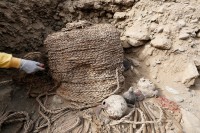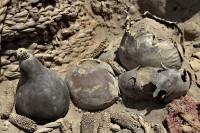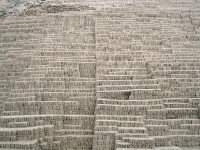 Two intact mummy bundles from the pre-Incan Wari civilization have been discovered inside the walls of the adobe and clay brick temple of Huaca Pucllana. Seventy burials have been found since intensive excavations began in 2005, but most of them are not intact. They’ve been damaged by deliberate human interference or simply the passage of time. The first intact burial found dates was a young woman with an exceptional death mask buried around 700 A.D. and unearthed in 2008. Two years later another female mummy buried around 850 A.D. with two infants and a young child was found undisturbed. Now three years after that a third intact burial has been found which early estimates date to around 1000 years old.
Two intact mummy bundles from the pre-Incan Wari civilization have been discovered inside the walls of the adobe and clay brick temple of Huaca Pucllana. Seventy burials have been found since intensive excavations began in 2005, but most of them are not intact. They’ve been damaged by deliberate human interference or simply the passage of time. The first intact burial found dates was a young woman with an exceptional death mask buried around 700 A.D. and unearthed in 2008. Two years later another female mummy buried around 850 A.D. with two infants and a young child was found undisturbed. Now three years after that a third intact burial has been found which early estimates date to around 1000 years old.
The two mummies are of different sizes, one is much larger the other and is probably an adult while the smaller one is the mummy of a child. The adult was a member of the elite, a high-ranking official or priest, and the little one may have been a child sacrificed in his or her honor, possibly even buried alive. Alternatively the child may be a relative who died at the same time. Both are wrapped snugly in woven rope bundles. The mummies are still in situ. They will be taken to a Ministry of Culture lab for testing to determine their age and sex. The full array of tests should take about six months, after which we’ll know what diseases they may have had, what they ate, the kind of work they did, and if DNA collaborates, whether the two are related.
 Nestled in the cavity along with the mummies, archaeologists also found seven vessels used to drink mate, 12 textile bags and the skeletal remains of three guinea pigs. The burial site was carved out of a wall on the sixth platform of the pyramid, one of the most thoroughly looted areas of the Huaca Pucllana complex. Destruction began long before the arrival of the Spanish, which makes the human remains and artifacts particularly rare survivals and this tomb one of the most important discoveries made at the site.
Nestled in the cavity along with the mummies, archaeologists also found seven vessels used to drink mate, 12 textile bags and the skeletal remains of three guinea pigs. The burial site was carved out of a wall on the sixth platform of the pyramid, one of the most thoroughly looted areas of the Huaca Pucllana complex. Destruction began long before the arrival of the Spanish, which makes the human remains and artifacts particularly rare survivals and this tomb one of the most important discoveries made at the site.
The pyramid long predates the Wari. The Huaca Pucllana complex was a ceremonial and administrative center built by the Lima culture between 200 and 650 A.D. in what is today the tony neighborhood of Miraflores. The Lima used a construction system known as the “bookshelf” style wherein hundreds of thousands of clay bricks are stacked together like books on shelves. Over time they lean in towards each other at opposite angles, like books on a shelf that isn’t completely full. This made the pyramids highly resistant to earthquakes.
 When the Wari spread out from their capital of Ayacucho (about 200 miles southeast of Lima in the Andes) and reached Lima around 650 A.D., they put their own imperialist stamp on the previous culture’s monuments: they buried their elite inside the walls of the pyramids. It was a means to assert their dominance over the Lima culture and to give their important dead impressive eternal resting places.
When the Wari spread out from their capital of Ayacucho (about 200 miles southeast of Lima in the Andes) and reached Lima around 650 A.D., they put their own imperialist stamp on the previous culture’s monuments: they buried their elite inside the walls of the pyramids. It was a means to assert their dominance over the Lima culture and to give their important dead impressive eternal resting places.
All the archaeological excavations, research and maintenance of Huaca Pucllana is funded by revenues from the site’s museum and restaurant. Last year, 60,000 visitors went to see the temple; the number is expected to rise to 100,000 this year. The museum is innovative in its exhibits as well, including a room designed for the visually impaired with replicas of ancient artifacts visitors can touch and Braille descriptions. If you’re ever in Lima, Huaca Pucllana is not to be missed.
Wow! Those finds are in brilliant condition! I wonder what that red fabric near the vessels is.